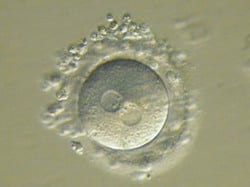After countless injections, needles sticks, and ultrasounds the day for your oocyte (egg) retrieval has finally arrived. Over the next few days, your nurse will tell you the number of eggs that were retrieved, how many of them fertilized, and how many have reached the blastocyst stage.
Each blastocyst is then graded by an embryologist based on cell development. The Gardner system of embryo grading was developed in the 1990s and allows the embryologist to give each embryo a quality score based on three distinct parts of a mature embryo also called a blastocyst.
Oocytes are retrieved from the ovaries by a transvaginal aspiration needle. The retrieved oocytes are then visually inspected to determine which are mature and ready to be fertilized by the partner or donor sperm.
Fertilization can be attempted by conventional IVF which mixes a known concentration of motile sperm with each oocyte, or by intracytoplasmic sperm injection (ICSI) which injects a single selected sperm into each oocyte. The egg and sperm mixtures are then placed in the incubator until the next day when they are inspected for the presence of fertilization.
Successfully fertilized eggs, now deemed day 1 embryos, are incubated for two additional days. On day 3, the embryos are reassessed and should now contain 6-8 cells to have the best chance for a successful pregnancy.
However, all embryos continue to be cultured despite their day 3 assessments.
On day 5, the embryos are reassessed and will be given their grade which consists of a number and two letters. At this stage, embryos are referred to as blastocyst and should now have two distinctive cell layers: the inner cell mass (ICM) which becomes the fetus and the outer layer of cells, known as the trophectoderm (TE), which becomes the placenta.
The number identifies how much the embryo has expanded and/or hatched and ranges from 1-6, with a 6 indicating the embryo has completely hatched from its protective shell and is fully expanded. The next two letters then give the assessment of the two distinctive layers, ICM and TE, and are grade A-C. For example, an embryo with a score of 6AA, would be described as a hatched and fully expanded, with a tightly packed ICM, and a cohesive outer layer of cells. It is important to note that a 6AA graded embryo is rare, while grades of 5’s and B’c are much more common.
It is the RMA policy to transfer the best quality embryo(s) using the Gardner scale of grading. For those patients that choose to have comprehensive chromosomal screening (CCS) performed on their embryos, the embryologist will choose the embryo(s) that are chromosomally normal above the visual grading scale.




